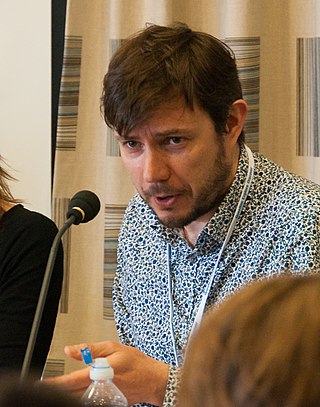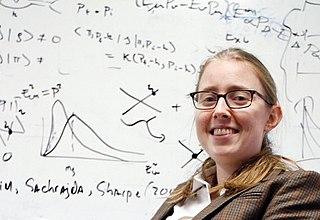Related Research Articles

Physics is the natural science of matter, involving the study of matter, its fundamental constituents, its motion and behavior through space and time, and the related entities of energy and force. Physics is one of the most fundamental scientific disciplines, with its main goal being to understand how the universe behaves. A scientist who specializes in the field of physics is called a physicist.

Particle physics or high-energy physics is the study of fundamental particles and forces that constitute matter and radiation. The field also studies combinations of elementary particles up to the scale of protons and neutrons, while the study of combination of protons and neutrons is called nuclear physics.
Supersymmetry is a theoretical framework in physics that suggests the existence of a symmetry between particles with integer spin (bosons) and particles with half-integer spin (fermions). It proposes that for every known particle, there exists a partner particle with different spin properties. There have been multiple experiments on supersymmetry that have failed to provide evidence that it exists in nature. If evidence is found, supersymmetry could help explain certain phenomena, such as the nature of dark matter and the hierarchy problem in particle physics.

Frank Anthony Wilczek is an American theoretical physicist, mathematician and Nobel laureate. He is the Herman Feshbach Professor of Physics at the Massachusetts Institute of Technology (MIT), Founding Director of T. D. Lee Institute and Chief Scientist at the Wilczek Quantum Center, Shanghai Jiao Tong University (SJTU), distinguished professor at Arizona State University (ASU) and full professor at Stockholm University.

Lisa Randall is an American theoretical physicist and Frank B. Baird, Jr. Professor of Science at Harvard University. Her research includes the fundamental forces of nature and dimensions of space. She studies the Standard Model, supersymmetry, possible solutions to the hierarchy problem concerning the relative weakness of gravity, cosmology of dimensions, baryogenesis, cosmological inflation, and dark matter. She contributed to the Randall–Sundrum model, first published in 1999 with Raman Sundrum.
Michael Edward Peskin is an American theoretical physicist. He is currently a professor in the theory group at the SLAC National Accelerator Laboratory.

Maria Spiropulu is a Greek particle physicist. She is the Shang-Yi Ch'en Professor of Physics at the California Institute of Technology.

Katherine Freese is a theoretical astrophysicist. She is currently a professor of physics at the University of Texas at Austin, where she holds the Jeff and Gail Kodosky Endowed Chair in Physics. She is known for her work in theoretical cosmology at the interface of particle physics and astrophysics.
Steven Scott Gubser was a professor of physics at Princeton University. His research focused on theoretical particle physics, especially string theory, and the AdS/CFT correspondence. He was a widely cited scholar in these and other related areas.

The Particle Physics Project Prioritization Panel (P5) is a scientific advisory panel tasked with recommending plans for U.S. investment in particle physics research over the next ten years, on the basis of various funding scenarios. The P5 is a temporary subcommittee of the High Energy Physics Advisory Panel (HEPAP), which serves the Department of Energy's Office of Science and the National Science Foundation. In 2014, the panel was chaired by Steven Ritz of the University of California, Santa Cruz. In 2023, the panel was chaired by Hitoshi Murayama of the University of California, Berkeley.

JoAnne L. Hewett is a theoretical particle physicist on the faculty of the SLAC National Accelerator Laboratory at Stanford University, where she is a professor in the Department of Particle Physics and Astrophysics. Since 2017 she has been the associate lab director of the Fundamental Physics Directorate and the chief research officer at SLAC. Her research interests include physics beyond the Standard Model, dark matter, and hidden dimensions. She is a fellow of the American Physical Society and a fellow of the American Association for the Advancement of Science (AAAS).

Jeffrey Robert Forshaw is a British particle physicist with a special interest in quantum chromodynamics (QCD): the study of the behaviour of subatomic particles, using data from the HERA particle accelerator, Tevatron particle accelerator and the Large Hadron Collider (LHC) at CERN. Since 2004 he has been professor of particle physics in the School of Physics and Astronomy at the University of Manchester.
National Center for Theoretical Sciences (NCTS) in Taiwan was established on August 1, 1997 and fully funded by the National Science Council (NSC), which is reorganized and became Ministry of Science and Technology (Taiwan) (MoST) in 2014, with strong endorsement from some of the most eminent scholars, including Yang Chen-Ning and Shing-Tung Yau. It is a national research center with the goal to contribute to the advancement of frontier research, and to promote interdisciplinary and international research cooperation in theoretical sciences.
Claudia de Rham is a Swiss theoretical physicist working at the interface of gravity, cosmology and particle physics. She is based at Imperial College London. She was one of the UK finalists in the Physical Sciences and Engineering category of the Blavatnik Award for Young Scientists in 2018 for revitalizing the theory of massive gravity, and won the award in 2020.
Natalia Toro is an American particle physicist known for her pioneering work in the study of dark matter. Based at the Perimeter Institute for Theoretical Physics in Waterloo, Ontario, Toro was the youngest winner of the Intel Science Talent Search and was awarded the 2015 New Horizons in Physics Prize.

Glennys Reynolds Farrar is a professor of physics at New York University who specializes in particle physics, cosmology and the study of dark matter. She has made several significant contributions to the fields of hadron and dark matter phenomenology, helping to develop the working "Standard Cosmological Model". Farrar is a figure in developing many modern particle-search techniques, achieving numerous recognitions including as the Guggenheim Fellowship for Natural Sciences and Sloan Fellowship. She holds a faculty position at New York University (NYU), where she has been since 1998.

Anastasia Volovich is a professor of physics at Brown University. She works on theoretical physics: quantum field theory, general relativity, string theory and related areas in mathematics.

Phiala Elisabeth Shanahan is an Australian theoretical physicist who lives and works in the United States. She is known for her work on the structure and interactions of hadrons and nuclei and her innovative use of machine learning techniques in lattice quantum field theory calculations.
Sinéad Farrington is a British particle physicist who works on the ATLAS experiment at the Large Hadron Collider.

The TUM School of Natural Sciences (NAT) is a school of the Technical University of Munich, established in 2022 by the merger of various former departments. As of 2022, it is structured into the Department of Biosciences, the Department of Chemistry, and the Department of Physics. The school is located at the Garching campus.
References
- 1 2 3 4 Bailer, Darice (December 24, 2000). "The View From / Westport; It's a Quantum Leap For High School Senior". The New York Times . Retrieved November 10, 2015.
- ↑ "Princeton Department of Physics: Mariangela Lisanti". Princeton University . Retrieved January 12, 2017.
- 1 2 "Quantum science, particle physics and nanoscale motors awarded support from Eric and Wendy Schmidt Transformative Tech Fund". Princeton University. Retrieved 2021-08-03.
- 1 2 Bermudez, Adam (February 13, 2014). "Bronx Personalities: Dr. Mariangela Lisanti, Renowned Theoretical Physicist at Princeton". The Bronx Chronicle. Retrieved November 10, 2015.
- 1 2 3 Zandonella, Catherine (March 5, 2015). "Lisanti: Perspective on the nature of dark matter". Princeton University. Retrieved November 10, 2015.
- 1 2 "Mariangela Lisanti, 18". MIT Technology Review . 2002. Retrieved November 10, 2015.
- 1 2 "Mariangela Lisanti". Blavatnik Awards. 2013. Retrieved November 10, 2015.